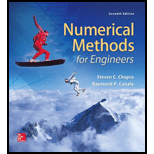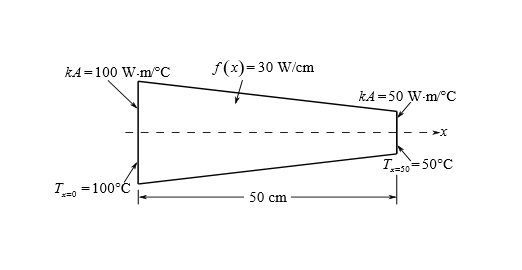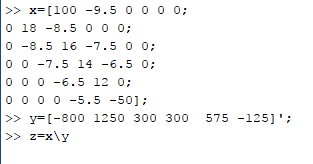
Concept explainers
To calculate: The temperature distribution in a rod as shown in figure below with internal heat generation using the finite-element method and also derive the element nodal equations using Fourier heat conduction.

Answer to Problem 12P
Solution: The temperature distribution in a rod at various nodes is shown below,

Explanation of Solution
Given Information:
To develop nodal equations for the temperature and their gradients at each of the six nodes. The element nodal equations is given as,
With the heat conservation relationships is,
Here,
The given rod is 50 cm long, the x-coordinate is positive to the right end and zero at the left end,
Calculation:
The element 1 the equations for the node 1 and node 2 is,
Solve the equation for node 1,
Substitute the value from given data,
Change the temperature so the equation becomes,
Solve the equation for the node 2,
Substitute the values from given data,
So, the equation of node 2 is,
Similarly, the value for other nodes is calculated. For element 2 at node 2,
Substitute the values from given data,
Change the state so the equation becomes,
Derive for node 3,
Substitute the values from given data,
So, the equation of node 3 is,
Derive the equation for the element 3,
Node 3
Substitute the values from given data,
Change the state so the equation becomes,
Derive for node 4,
Substitute the values from given data,
So, the equation of node 4 is,
Derive the equation for the element 4,
The equations for node 4 is,
Substitute the values from given data,
Change the state so the equation becomes,
Derive the equation for the node 5,
Substitute the values from given data,
So, the equation of node 5 is,
Derive the equation for the element 5,
For node 5,
Substitute the values from given data,
Change the state so the equation becomes,
Derive the equation for node 6,
Substitute the values from given data,
So, the equation of node 6 is,
The equation assembly is given as,
Insert the boundary conditions then the matrix becomes,
Use MATLAB to write code for solving the matrix,

The desired output is,

Want to see more full solutions like this?
Chapter 31 Solutions
Numerical Methods for Engineers
 Advanced Engineering MathematicsAdvanced MathISBN:9780470458365Author:Erwin KreyszigPublisher:Wiley, John & Sons, Incorporated
Advanced Engineering MathematicsAdvanced MathISBN:9780470458365Author:Erwin KreyszigPublisher:Wiley, John & Sons, Incorporated Numerical Methods for EngineersAdvanced MathISBN:9780073397924Author:Steven C. Chapra Dr., Raymond P. CanalePublisher:McGraw-Hill Education
Numerical Methods for EngineersAdvanced MathISBN:9780073397924Author:Steven C. Chapra Dr., Raymond P. CanalePublisher:McGraw-Hill Education Introductory Mathematics for Engineering Applicat...Advanced MathISBN:9781118141809Author:Nathan KlingbeilPublisher:WILEY
Introductory Mathematics for Engineering Applicat...Advanced MathISBN:9781118141809Author:Nathan KlingbeilPublisher:WILEY Mathematics For Machine TechnologyAdvanced MathISBN:9781337798310Author:Peterson, John.Publisher:Cengage Learning,
Mathematics For Machine TechnologyAdvanced MathISBN:9781337798310Author:Peterson, John.Publisher:Cengage Learning,






